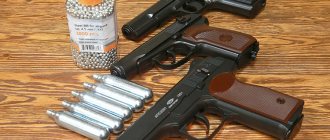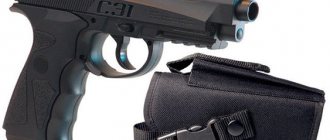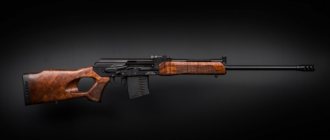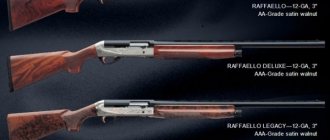Definition
A rifle is a small rifled weapon that has a butt to rest on the shoulder when shooting. The first screw guns appeared in the century before last; they became a replacement for the musket - a weapon that was distinguished by imprecise aiming and a heavy barrel. Rifles were used in the First and Second World Wars, and it was during these periods that they began to be manufactured in all countries. Nowadays the rifle is widely used by hunters; permission to store it is required.
Dragunov sniper rifle
A carbine is a lightweight version of a rifle with a shortened barrel. This type of firearm has become an excellent alternative to its predecessor due to its low weight. But due to its reduced size, the carbine is inferior in many respects to the rifle. Without official registration, these weapons are unacceptable for use.
Small-caliber carbine "Yastreb"
Difference between carbine and rifle
Main difference
We may know the general difference between two weapons, but much more goes through their system and works to infer how they operate themselves. This article discusses two subjects: the carbine and the rifle, weapons that have become deadly in their own way. This article discusses the differences between the two and the main difference between the two is that a firearm with a longer handle than others but with a shorter barrel is known as a carbine. While a weapon, especially one fired from shoulder level, having a long barrel with spiral grooves to fire the bullet, is called a rifle.
comparison table
| Basis of difference | Carbine | Rifle |
| Definition | A firearm with a longer handle than others, but with a shorter barrel. | The weapon, fired from shoulder level, has a long barrel with spiral grooves to spin the bullet. |
| Accuracy | Less accuracy at long range. | Have greater accuracy over long distances. |
| Size | Barrel measures less than 20 inches. | The barrel measures over 20 inches. |
| Disposal | Short range shooting, secret missions and permanent residence. | Wars, long action, requiring proper ammunition and high speeds. |
| Working | Shoots one bullet at a time. | Fires multiple bullets at once. |
| Weight | Smaller rifle | More than a carbine |
Carbine
A carbine is defined as a firearm with a longer handle than others but a shorter barrel. They are lighter in weight and much smaller in size than other weapons. Thus, it becomes easy to handle them over long distances and use them without any problem. For the reason stated here, such weapons are mainly used by soldiers who participate in extreme operations, such as paratroopers and special army operators. Such weapons also become available to officials who do not have to participate in wars and have secondary uses for things that are of little value. But when conditions get harsh, such as on the front lines of a war, carbines become useful because they weigh much less and load quickly. The word came as "carabinieri" from the French word carabine, it also came from the Old French word carbine, meaning a soldier armed with a musket. It is generally assumed that the term is derived from the word escarrabin, gravedigger, which is derived from scarab, the scarab beetle. They were originally developed because most soldiers had to travel on horseback and did not have the ability to carry larger guns, although they were designed for such purposes in cavalry, the action was not successful as the ride was unstable. Such weapons were often used in the world wars and took over the role of larger guns in areas where the war had just ended or where the army needed to stay longer to negotiate. They were developed because most soldiers had to travel on horseback and did not have the ability to carry larger guns, although they were designed for such purposes in cavalry, the action was not successful as the ride was unstable. Such weapons were often used in the world wars and took over the role of larger guns in areas where the war had just ended or where the army needed to stay longer to negotiate. They were developed because most soldiers had to travel on horseback and did not have the ability to carry larger guns, although they were designed for such purposes in cavalry, the action was not successful as the ride was unstable. Such weapons were often used in the world wars and took over the role of larger guns in areas where the war had just ended or where the army needed to stay longer to negotiate.
Rifle
A rifle is defined as a weapon, especially one fired from shoulder level, having a long barrel with spiral grooves to spin the bullet and thus provide greater accuracy at long range. The barrel has spiral grooves, areas that rise above other parts, called lands, and come into contact with the projectile. This action helps to make rotation around the axis in accordance with the movement of the weapon. The process of working with such a gun is complex compared to others, but its range is much greater. The bullet present in the weapon is ejected due to the ignition of the explosive, which was originally black power and later changed to cordite. Modern guns use nitrocellulose, but other materials such as compressed air can also be useful. Originally, the guns manufactured were designed to fire one bullet per pull of the trigger, but over time some changes have occurred and the modern version is capable of firing one shot in a few seconds. This led to its use in wars and other operations requiring more ammunition and considered important. Most countries have developed their own versions, but the most famous ones still belong to Russia. The first war of the 20s but the most famous ones still belong to Russia. The first war of the 20s but the most famous ones still belong to Russia. The first war of the 20th century between Russia and Japan was the first time such weapons were used, and the world needs to see the potential of these dangerous weapons.
Key differences
- A weapon having a barrel measuring more than 20 inches is called a rifle, on the other hand, weapons having a barrel measuring less than 20 inches are called carbines.
- A carbine is defined as a firearm with a longer handle than others but a shorter barrel. On the other hand, a rifle is defined as a weapon, especially fired from shoulder level, having a long barrel with spiral grooves to spin the bullet and thus be more accurate at long range.
- The carbine weighs less than a rifle due to the difference in size.
- Rifles become useful for wars and other long-duration activities that require proper ammunition and high speeds, while carbines come in handy for purposes such as short-range shooting, secret missions, and permanent residence.
- The main purpose of developing carbines was to create a weapon that could be used while riding on horseback, while the main purpose of the rifle was to improve weapons for warfare.
- A carbine fires one bullet at a time in a conventional gun, while a rifle can fire multiple rounds at a time.
Comparison
The main difference between the rifle is the large barrel size. The weapon has more weight and is quite difficult to use. The carabiner, on the contrary, is quite compact, which allows you to use it for a long time without unnecessary strain in your hands and stress on your shoulders.
If you take a classic rifle, it is designed for only one cartridge, after which it needs to be reloaded. The carbine has a magazine for several shots. But if we take into account modern types of rifles, then in this they are no different from their counterparts.
The carbine has additional accessories, for example, a bayonet. During the war, such weapons made it much easier for soldiers to perform various tasks. And in the absence of cartridges, they could neutralize enemies not only with a butt, but also with a knife. This is also a definite plus when hunting.
The rifle is capable of shooting at a greater distance. A fired bullet can travel a distance of 2000 meters. Of course, this is not very useful when hunting, since a person will not see the target at such a distance. However, from a distance of 200 meters the blow will be very powerful, even a huge bear cannot resist it. The carbine does not have this ability. Bullets can travel a maximum distance of 800 meters. Accordingly, when shooting at 200 meters, it is not always possible to kill the victim the first time, if we are talking about large animals. If you hunt small animals or birds, then one bullet will be enough.
A daily boost of fighting spirit!WARHEAD.SU
Weapons terminology is not fundamental, and some changes occur over time. Again, you need to understand that domestic terminology differs from foreign ones.
Here, for example, is the word “automatic”: in Russia/USSR, until the middle of the last century, both the Fedorov automatic rifle and the Shpagin submachine gun were called this, and what we today consider an “automatic” (that is, a weapon chambered for an intermediate cartridge with a bottle shape cartridges capable of firing bursts) simply did not exist.
Or, say, the French Fusil-Mitrailleur Chauchat Mle 1915 CSRG was called a “machine gun” during the years of active use. But what kind of “gun” is this if it’s rifled? According to today's classification, we consider the Shosh a “light machine gun.”
Or anti-tank PTRS and PTRD (Simonov and Degtyarev anti-tank rifles) - they are also rifled, where does the word “gun” come from again? Modern classification classifies them as “anti-material rifles.”
It's the same with the term "carbine". Initially, this was the name for a long-barreled rifled handgun with a butt, the barrel of which was shorter than that of the “full-fledged” models that existed at that time. As a rule, it was used by cavalrymen and had worse accuracy and firing range - these characteristics were sacrificed for the sake of compactness.
This situation lasted until the end of the 19th century, when technological developments led to the creation of reduced-caliber cartridges using smokeless powder. Such ammunition made it possible to sharply reduce the length of the weapon barrel, and the new “carbines” were no longer inferior to the old full-size rifles. Their belonging to the cavalry was revealed only by the attachment of swivels under the belt: not from the bottom, but from the side, so that they could carry the weapon on the back and not on the shoulder.
The main confusion began right around World War II: new classes of weapons for previously non-existent ammunition entered the arena, and they also had to be called something.
The American M1 Winchester carbine was in no way a shortened version of the M1 Garand rifle - it was an independent weapon chambered for the original .30 Carbine cartridge; It’s just that the names of two different types of weapons coincided - we had to somehow get out of it.
Simonov's domestic self-loading carbine, despite the fact that the principle of operation of its automation coincided with the automatic rifle mod. 1936 by the same author, was also designed for a different cartridge, and it did not have a “full-size” version accepted for service. It was just smaller in size than the Mosinka model. 1891/30.
Finally, the German “Sturmgewehr”, despite the word gewehr contained in the name, were not, in fact, rifles, since they were clearly smaller in size than the German k98 carbines. Upon further study, Soviet and American testers considered them precisely “automatic carbines.”
And so on.
Today this concept itself is outdated. Although the domestic GOST 28653-2018 “Small arms” defines a carbine as a “short rifle,” there is not the slightest reason for this. Compared to the first examples of rifled weapons, all modern rifles look much shorter, so some domestic enthusiasts believe that the very word “rifle” is outdated, and all long-barreled rifles should be called “carbines.”
By the way, in the USSR/RF there was a kind of unspoken tradition of calling all rifled hunting weapons “carbines”. Even the decommissioned Tokarev SVT-40 rifle, which fell into the hands of hunters, was called the “SVT-O hunting carbine.”
But this homemade “custom” has now been violated: for example, ORSIS civilian products are called “rifles.” Domestic manufacturers generally have difficulties with the names of their products. It is enough to recall the “smooth-bore tactical carbine “Saiga” 12 gauge” to understand: GOSTs are not a decree for our marketers...
Finally, according to current Russian legislation, the same self-loading carbine SKS mod. 1945, which has a Lancaster or Paradox rifled barrel, is a smoothbore weapon.
There was a carbine - it became a gun.
Don't try to understand it. Just accept it as it is: everything changes, and so does weapon terminology.
Carbine vs rifle
If you're new to firearms, you might want to think about the differences between different guns, particularly a carbine and a rifle. This is not surprising since they are similar in appearance. However, once you use them, you will find that a carbine and a rifle operate differently.
The most obvious difference between a carbine and a rifle is their length. The carbine comes with a shorter barrel, making it lighter. Consequently, some officers like to use a carbine during a firefight because it is easier to handle. Of course, this does not mean that a carbine is more accurate or effective than a rifle. In fact, if handled properly, there is no reason for a rifle to be any less accurate than a carbine.
Physics, however, plays a large role in the power that supports a bullet when fired from a carbine or rifle. Because the rifle is longer, the expanding air has more time to produce energy to increase the impact of the projectile. As a result, not only is the rifle heavier, but the shooter can actually feel more energy coming from the rifle when shooting.
The term "rifle" also refers to the fact that the barrel of this firearm is "rifled" or grooved. This means that when the round comes out of the gun, it adapts a special spin that adds force behind the shot. For this reason, the projectile becomes more stable as it travels through the air, increasing accuracy. Naturally, the bullet's "spin" also means that it travels a predictable path to the target. Specifically, a bullet fired from a rifle moves 1-2 centimeters every 100 meters, as long as there is no wind to affect the bullet's travel. For this reason, people who carry a rifle are much more likely to predict where a bullet will hit.
Shotgun VS rifle: which weapon is better for defense?
Since 2017, we have taken a new look at the good old shotgun. This weapon has many names, and the most common ones are “shotty”, “bitch”, “gauge”, “room broom” and “boom stick”, thanks Evil Dead).
As the title suggests, this article will answer the question - why would I (Greg Nichols, emeritus member of Suarez International - approx. per) take a shotgun rather than a rifle? And also, what is the advantage of this weapon over others used for defense? And finally, which shotgun would I choose: pump-action, semi-automatic, tube magazine or box magazine, etc.?
Shotgun or rifle? Which firearm is best for defense?
Now a fashionable trend has arisen - to take the shotgun out of its usual scope of use in order to use it in situations approximately similar to rifles. That is, it can be used both for combat with one enemy and for mass destruction. Shotguns are also used for entertainment (for example, to shoot at clay pigeons). It seems to me that this use of a combat shotgun is a stupid departure from its real purpose.
But guys, it's all about efficiency and when it comes to pump action guns and rifles, recoil doesn't make that much of a difference. There is an excellent and easy technique for reloading a shotgun using recoil: you can fight it or use it to speed up the process. I'm not specifically discussing how to do this, but if you're on the same page as me, you'll eventually figure out how to do it.
When I choose a combat rifle or pistol, there are criteria by which I focus. The same goes for the shotgun. Semi-automatic or pump action is what matters to me when choosing a shotgun. I'll explain the reason for this below, as well as why I prefer a tube magazine. However, I would not choose a lever action or bolt action on a shotgun; I'd prefer a rifle instead.
How to feed the “beast”?
There are three types of shotgun reloading systems - three ways to feed the war beast.
Wedge gate
When it comes to combat shotguns, these types of weapons are considered relics. As with lever-action and bolt-action shotguns, these weapons are simply pathetic in real combat. Are you using this one? If so, it's most likely because you simply have no alternative. You shouldn't torture yourself when there are so many alternatives around. I wouldn't choose an M1 Garand over an M-4 for real-world combat any more than I would take a bolt action weapon over a magazine-fed weapon. The only possible benefit I can think of is that on dual trigger models I can release both triggers at the same time for a more powerful shot, or shoot pellets from one barrel and slugs from the other.
Box magazine
I don’t want to rewrite Gabe Suarez’s article covering this topic, so let’s put discussions about the quality of stores aside. A huge advantage of such shotguns is their speed. You can reload your weapon in literally a matter of seconds. But from my point of view, there are no serious advantages here.
It is clear to anyone who knows how to handle a weapon that if you are in a position where you need to quickly reload, you need to change your tactics, because you are doing something wrong. I will also add that in this case you do not understand the system of the weapon you are working with, not to mention the additional volume and weight of ammunition that you will have to lug around.
Tubular magazine
I prefer this reloading system as I fully understand how a shotgun is used in combat. If a shotgun is a real combat system for you, then you have to think of him as someone with a big mouth, a small belly and a short memory. As soon as you start to discharge it, do not forget to “feed it”. To use such a weapon requires a lot of practice, attention and understanding. No shotgun is designed to instantly empty its entire magazine (the AA12 is an exception). You need to constantly work with a shotgun: shoot, load, shoot, repeat. Since this reloading system is the best, according to many shooters, I will refer to it later in the article.
What can a shotgun do?
Siege and breakthrough
The shotgun is a great weapon for getting where you need to go. It's not very heavy, it's easy to carry and... a shotgun blast can knock down a door. Have you ever seen a rifle shot blow a door to pieces? Well, okay, if you try, you can do it. But a rifle cannot do this even in a dozen shots.
When it comes to an urban shootout, I don't want to carry a special battering ram with me, knowing that a couple of rounds will do the same thing, but it will even require less effort. Obviously, the rifle can't even compete with the shotgun in the siege and breaching department.
Energy Transfer (Battle Ax Theory by Gabe Suarez)
I would really like to talk about energy transfer when using a shotgun, because the main thing a shooter has is the power of his weapon. So let's look at this topic from a logical point of view.
The human body is a biomechanical machine, much like a car. To completely take someone out of the fight, you must attack and disable any of the 3 systems: electrical, hydraulic or air. As we know, hydraulic and air systems take time to fail: the more holes in the system, the faster the result. The electrical system (CNS) is the way to end the fight, so let's think about efficiency. With one shot from a shotgun, I can make eight to nine holes with a diameter of 7.62mm in the enemy’s body. And depending on the angle of attack and the spread of the buckshot, I can hit from one to all three vital systems (by the way, a wound inflicted from a shotgun leaves parts of the plastic from the cartridge in the enemy’s body, so it can lead to infection later). And as a bonus to shooting with a shotgun, you get the opportunity to incapacitate an enemy, even if he is protected by body armor.
A few professional observations. When I took two hits from the Remington 12GA, the first was not very serious - the bullet hit my wrist and spun me 180 degrees. But the second one hit me in the side, broke 3 ribs, cut my lung and threw me to the ground with a hole in my body the size of a melon. I bring this up because, in my own experience, even non-fatal hits that didn't end the fight—like a hit to my wrist—knocked me out of the fight for a second or two. If this had been a fight to the death, the third shot would have ended everything.
So here's the point. Speaking of working with a 7.62 caliber rifle or even smaller - yes, you have the ability to fire 30 bullets, but the question is how many people can you take down with it? Five? Well, six maximum? And as a result, such wastefulness leads you to an empty magazine, since you will spend 5-6 rounds on one enemy. What is more effective?
All the advantages of the rifle gradually disappear when it comes to close combat. The closer you are to the enemy, the more the rifle is inferior to the shotgun. With a rifle in my hands, I have a very interesting choice: either I will turn the enemy into a walking sieve, or I will receive one powerful hit and pass out. If my opponent has a shotgun, then the probability of the second outcome is high, especially considering the spread of the shot. By the way, one shot from a shotgun launches a whole handful of damaging elements at the enemy, while a rifle sends only one bullet to the target.
Fast manual reload
When compared to using a magazine (both rifle and shotgun), manual shotgun reloading is rightfully considered the fastest of all reloading methods. Now she looks slow, but she cannot be called a “waste of time.” With this reloading method, you won't be loading a full magazine if you don't need it; you don't put a half-empty magazine in your backpack and throw it away. You don't have to keep extra magazines or wait until they're completely empty when reloading your shotgun—you're feeding the beast in small portions, so to speak.
Best Uses for a Shotgun
Operations in urban environments
We have already talked about the ability to break down doors. Let's look at other advantages of shotguns in such operations. The shotgun is the king of melee combat. At close range, I don't need perfectly precise aiming to hit the target (as shown above). In CQB (Close Quarters Battle - combat in a confined space, such as indoors), even if the shotgun is not equipped with a red dot sight, I can aim well enough to deal significant damage. If the battle takes place indoors, then in this case a shotgun is indispensable. If we consider tactical shotguns without a stock (PGO, pistol grip only), they are extremely maneuverable inside buildings and can incapacitate opponents on the other side of the room. Also, as mentioned above, even if the shot misses, the enemy can be wounded by one of the pellets/buckshots (due to their large number).
As I mentioned at the beginning, if I'm in an urban environment and need to either attack or navigate multiple buildings, with a shotgun I can open doors/gates much faster than if I was just trying to kick, knock, or ram them. You can also shoot through walls and other obstacles. This feature also works on thick metal, concrete, asphalt, cinder block and brick. This means that you can hit an enemy who is hiding around a corner, behind a wall, and so on. Also remember that a shotgun blast can travel through the engine compartment and hit the legs of the enemy in the car chasing you. This is the "non-standard" advantage of lower speed. The shotgun's lower speed and efficiency in transferring energy also counts in urban areas due to the lower likelihood of ricochet and associated injury (to you or your comrades).
Each weapon platform has its own specialization. for this reason I have three M-4 rifles: one is an AR-15 with RDS (for street combat or CQB); the second - with a 16” barrel and a 1-4 optical sight (for standard use); the third is an 18” barrel with 1-6x optics (for accurate shooting at a distance). You will most likely agree that each platform, be it pistol, rifle or shotgun, has different ranges to hit, and in many cases they can be compared to find the one that is right for YOU.
Inside the building, at a distance of 35 meters or so, there is complete freedom for a shotgun. In this situation, it is much more effective to damage the 3 life systems, but distance is the determining factor for effectiveness. Everything that makes a shotgun a close-combat weapon (energy transfer and projectile spread) begins to hinder its effectiveness at a certain point. The further you are from the target, the less effective the shotgun is.
The two real differences between the Rifle and Shotgun are distance and accuracy.
If I take a shotgun with a collimator, its affected area will rise to 100-150m. With a rifle, this figure will be above three hundred meters, but the effectiveness at 30-35 meters will not be so high. Always keep the context in mind. I know I can't lay down sustained suppressive fire—this is not a shotgun mission—but the pellets, buckshot, and slugs whizzing past the enemy will definitely keep them on their toes. With a high probability of being wounded, you would also not stick your head out of cover. Even an indirect hit may not kill, but simply incapacitate, but this is also dangerous.
Low light/total darkness conditions
Due to the fact that the flash when fired from a shotgun is not very bright, it becomes a good weapon for fighting in low light conditions. I just love using shotguns in these conditions. Which I had the opportunity to demonstrate in Sua and during my wilderness weekend in Texas early last year. Then I used a Remington 870 (which I had never handled before) that belonged to another instructor. Even using unfamiliar ammunition, I was able to knock out 5 out of 5 targets using only moonlight as a guide. I showed this result at a distance of about 20-25 meters, and very few of our students could go with a score of 5 out of 5 using night vision devices and rifles. Also, to shoot more efficiently, you can use a special DTK for an environment without light or with low light levels.
Shooting at a moving target
Again, due to the spread of buckshot, the multitude of shells and the ability to penetrate obstacles, the percentage of hits from a shotgun on moving targets compared to a rifle is simply indecently high. This is why you don't see shooters using .410 caliber rifles for these actions. It's pretty obvious.
Choosing Shotgun Ammo
Bullet
I do not perceive the bullet as a full-fledged ammunition for smooth-bore weapons. It seems to me that such ammunition is used only to show off its toughness. While a trained person is loading the weapon with a bullet, I will already have time to change weapons and fire the pistol. However, it is important to note that this ammunition is excellent for shooting through walls and other semi-permeable surfaces such as car body and glass. In general, I recommend carrying 3-5 of them, but not pre-loading them when shooting the shotgun.
Police non-lethal ammunition (“bean bags”)
I can't say much about these cartridges. Judging by the name, they have a minimal probability of killing the enemy (but still, there is such a probability). Since only the police have restrictions on the power of weapons and their lethality, I would not recommend anyone other than police officers to use them.
Powdered lead
Such ammunition is used for picking to reduce the number of splinters and fragments into which the lock will shatter when it is shot at. Just like the previous version, this version of shotgun cartridges has low lethality. When hit at close range, such cartridges pierce clothing and eat into fabrics. According to rumors, a very dirty wound is formed, which doctors will waste a lot of time cleaning. This is a special ammunition for hacking; using it in battle is more expensive. And by the way, these cartridges are very expensive. I recommend it only for opening locks.
Shot, buckshot
By far the most common of shotgun ammunition and, in my opinion, the best for anti-personnel operations. The market offers a wide selection of options for such cartridges. My favorites are #00, #000, #4 (Magnum Turkey) and so on. As I said earlier, a powerful rifle cartridge contains 8-9 pellets with a diameter of 7.62 mm, which, when fired, fly at a speed of 365-425 meters per second. But my favorite ammo is Magnum Turkey. Yes, they are lethal, and 57 grams of 3.2 mm diameter shells at a speed of 460 meters per second will stop anyone they hit.
The more projectiles, the higher my hit percentage, and they are still large enough to transfer a large amount of energy to the opponent's soft tissue, but depending on the impact location and distance, sometimes there may not be enough mass to penetrate organs. I've also used them to knock down doors and... even hit those behind the doors.
I mixed combinations of the three types of ammo like a cocktail that eliminated all sorts of troubles. I would also call this cocktail an advantage of the platform and tubular magazine.
These are all the main things I wanted to tell you about shotguns and rifles. I specifically avoided mentioning brands, accessories, sighting systems, and ammunition names. Such discussions are described in other articles, and if you need it, we’ll talk about them separately.
Original article: SHOTGUN VS RIFLE
Atom, assault rifle, carbine. What is the difference? How do they differentiate?
Recently I witnessed an argument between two young people who were arguing about the classifications of various small arms. And I also wondered, indeed, what is the difference between a carbine and a rifle, and how to determine which is which, or how, for example, do they distinguish between assault rifles and machine guns, and is there any difference between them at all? There were various variations on the division of small arms into carbines and rifles, for example, there was an assumption that carbines are simply shortened rifles, and there was an option that carbines are self-loading rifles, while ordinary rifles need to be reloaded every time. And all this only led to even bigger questions, for example, what is the difference between self-loading rifles and automatic ones? Or is it the same thing? In general, this confused me too, and I decided to look for information about the classification of weapons on the Internet, and found out that it turns out there is a special GOST, which makes it clear the differences between all this division.
This GOST can be freely found on the Internet. GOST 28653-90 (https://docs.cntd.ru/document/1200015064).
And here's what I found about this:
What is the difference between a shotgun and a shotgun? What is the difference between a shotgun and a rifle?
In Russia, pump-action shotguns were not widely used until the early 1990s, but today they have gained some popularity. Hollywood films contributed to this to some extent. There is still no tradition of hunting in Russia with a pump-action shotgun, since until the nineties, samples of pump-action shotguns came to us only sporadically. Today the model range, both Russian and foreign, is quite wide. After the liberalization of the weapons law, there were more pump-action shotguns on the Russian markets.
First, imported samples appeared on the market. In the 90s, imported pump-action shotguns were imported in greater quantities than representatives of other types of weapons. However, since 1997, due to the lack of tradition in the use of pump-action shotguns, as well as due to improper handling and care, the demand for pump-action shotguns began to decline. The preference of hunters has fallen on self-loading rifles. This is an inevitable process, because semi-automatic models are rightfully considered the most productive, especially in cases where the hunter has little experience.
It is worth noting that pump-action shotguns were undeservedly forgotten, since they are very suitable for hunting; the only thing in handling such shotguns is that you need to have at least some skill, as well as adhere to certain rules. Pump-action engines are more demanding, that’s all. If the hunter has good reloading skills for a pump-action shotgun, then the rate of fire will be no lower than the rate of fire of a semi-automatic machine. In terms of the speed of the 2nd shot, a pump-action shotgun differs from a semi-automatic shotgun just like a self-loading shotgun or a double-barreled shotgun.
TYPES OF SMALL WEAPONS
Weapon
Automatic/self-loading
Non-automatic small arms
Small arms in which all reloading operations are performed using the muscular energy of the shooter
Automatic small arms
Small arms with fully automated reloading
Self-loading small arms
Automatic small arms, the trigger mechanism of which allows only single firing
Single-shot small arms
Single-barreled small arms without a feed mechanism and with one chamber
Multi-shot small arms
Small arms with a feed mechanism or more than one chamber
Rifles and shotguns
This section contains information about various types of rifles, both domestic and foreign made. You can learn a lot about the best rifles in the world and the latest developments of weapons designers. We also bring to your attention materials about smooth-bore and rifled hunting weapons: hunting rifles and carbines.
A rifle is a type of firearm that has rifling in the barrel. Thanks to the rifling, the bullet acquires a rotational motion in flight, which significantly increases the accuracy of the shot. The first samples of rifles appeared back in the 16th century, but due to the high cost and difficulty in reloading, they were not widely used. These rifles were loaded from the muzzle.
Breech-loading rifles, which appeared only in the 19th century, became truly widespread. Their design was constantly improved, and at the same time conical bullets were invented. At the end of the century, several examples of reliable and powerful rifles appeared, which were used for many years and became legendary. The Russian army received the Mosin rifle, the Mauser rifle was created in Germany, and the British army received Lee-Enfield rifles.
During the First World War, sniper business began to actively develop. A sniper is a sharp shooter who must hit the target with the first shots. To do this, he needs a special weapon. Nowadays, snipers often use special ammunition with a more accurate powder load and bullet weight. In addition, to ensure an accurate shot, the sniper uses special tools that help accurately determine the distance to the target and the strength of the wind.
A sniper rifle is a weapon equipped with special sighting devices that allow you to increase shooting accuracy. Usually these are different types of optical sights. A modern sniper rifle is a true work of engineering art.
Today there are snipers in every infantry unit of any army in the world, and other security forces cannot do without them. Here you will find information about Russian sniper rifles and foreign developments in this direction.
There is another type of rifle called a carbine. It differs from a rifle in its smaller size and weight. The first carbines appeared as cavalry weapons. Today, a similar term is often used to describe smoothbore guns. Smoothbore rifles are usually used as hunting weapons or for self-defense. Hunting rifles are one of the most popular types of weapons among fans of this type of entertainment. The carbine is a weapon that is very popular among both professionals and amateur shooters. Russian carbines are some of the best carbines in the world, they are traditionally in great demand.
Rifles capable of automatic fire are often classified as a separate type of small arms; they are called assault rifles. In Russian literature they are usually called automata. The Kalashnikov assault rifle can also be classified as assault rifles. We have prepared materials about modern assault rifles from around the world that are in service today or were actively used in the past.
Currently, assault rifles are one of the most promising and dynamically developing types of small arms. We have selected information for you about Russian rifles, Ukrainian rifles, and weapons that are being developed in Europe, the USA and Israel.
Rifle barrel length
Rifles can have a barrel of very different lengths, from 40 to 80 cm. Both long and short barrels have their advantages and disadvantages. When choosing barrel length, the following points should be taken into account:
- Longer barrels provide greater muzzle velocity. Although this increase in speed is not very large: an increase in the length of a rifle barrel by 10 cm leads to an increase in the initial speed of the bullet by only 3-4%.
- The longer the barrel, the more of the powder burns inside the barrel. This is why longer barrels have less muzzle flash. The muzzle flash, when shooting at night and in the twilight, severely blinds the shooter and does not give him the opportunity to fire a quick second shot.
- A shorter barrel is stiffer than a longer one, so it is less susceptible to vibration and provides slightly greater accuracy. The relationship between accuracy and barrel length is so insignificant that it can be ignored when using a rifle for hunting.
- A shorter barrel weighs less, provides better balance to the rifle, and is easier to carry and carry.
Most rifles have barrel lengths that are multiples of inches, so we talk about 20″, 22″, 24″ and 26″ barrels. Some manufacturers adhere to the metric system in the length of their barrels.
Most modern rifles in standard calibers have a barrel length of 22″ to 24″ (56 to 61 cm). There are more and more standard caliber rifles with 20″ (50 cm) barrels. Magnum caliber rifles most often have a barrel length of 24″ to 26″ (61 to 66 cm).











